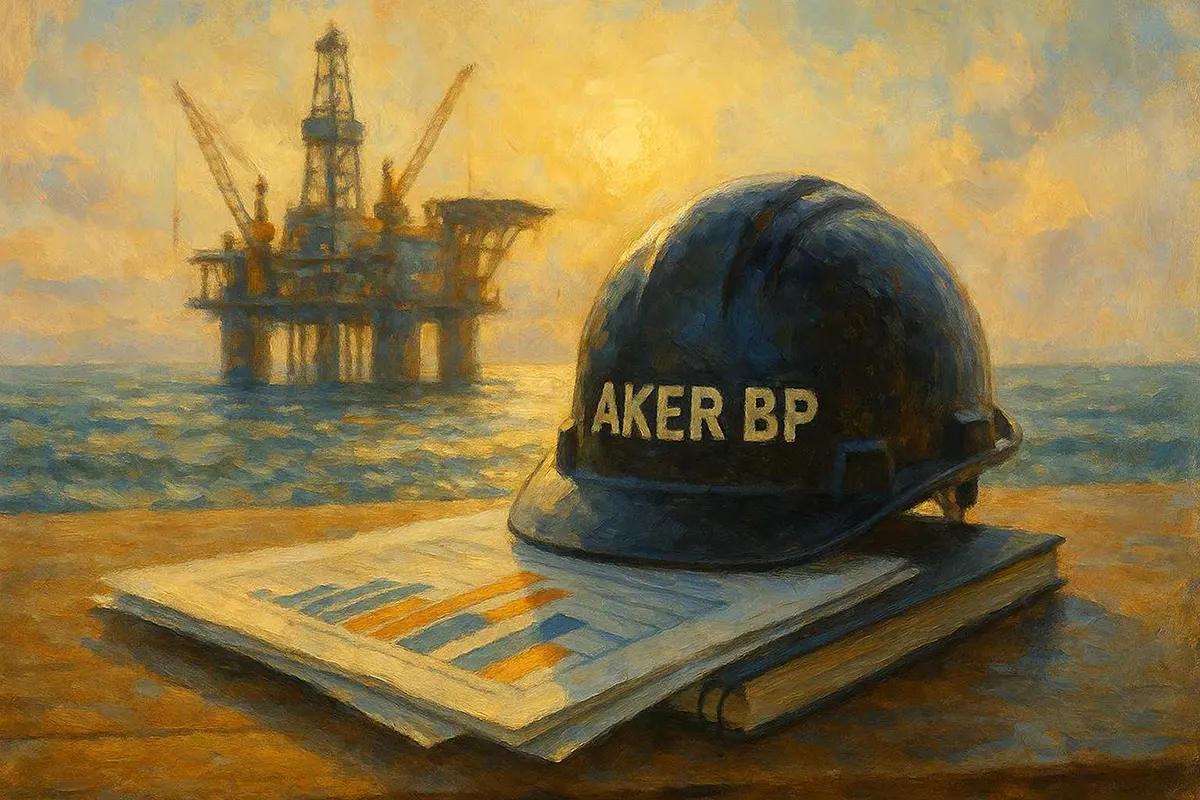This is Part 4 of my client letter on our purchase of Aker BP (AKRBP in Oslo). I explain how I discovered the company and why its “alliance model”, single-basin focus, and technology-first approach make it exceptionally efficient. You can read Part 1,2, and 3 here.
Why We Bought Aker BP: A Technology-First Oil Company (Part 4)
I stumbled on Aker BP completely by accident. I was having dinner with a good friend Rob Vinall in Omaha during Berkshire Hathaway’s annual meeting weekend. We were sharing our notes on International Petroleum (IPCO) – Rob is a shareholder as well. He asked me if I’d ever looked at Aker BP. I knew the Lundins had sold Lundin Energy to Aker BP (a Norwegian oil company) and were large shareholders, but I’d never looked at the stock. He said, “Take a look – you’ll like what you see.”
The very next day, I was having a conversation with another value investor who sits on the board of a Norwegian oil services company. I asked him if he knew much about Aker BP. His eyes lit up and he started telling me about their unique “alliance” model (I’ll discuss it soon). Right after I came home from Omaha, I dropped everything, and Max (our analyst) and I started studying Aker BP.
It’s truly an amazing company. Its single focus is on the Norwegian Continental Shelf (NCS), a vast submarine expanse that stretches across the North Sea, Norwegian Sea, and Barents Sea, spanning a little over two million square kilometers – roughly three times the size of Texas. This immense underwater territory, over which Norway holds sovereign rights over natural resources, has been a cornerstone of the country’s economy. Most of the NCS’s oil and natural gas reserves are 100-400 meters underwater, which is considered relatively shallow.
As we started studying Aker BP, we became fascinated by its “alliance model,” which it borrowed from Toyota and goes beyond traditional “kaizen” – continuous improvement. At its core, it aims to align incentives between the company and all of its suppliers.
Oil drilling in the sea is a team sport. In fact, an oil company is really a general contractor that manages a lot of suppliers: some provide and man rigs, another helps build the pipeline that gets oil from platform to shore, another owns and operates boats and helicopters that bring crew to and from platforms, another operates submarines and divers who install equipment on the sea bed. The list is endless. All these suppliers have their own agenda and have multiple balls in the air, many of which have little to do with Aker BP’s agenda.
There’s a great line from Brad Jacobs’ book How to Make a Few Billion Dollars that stuck with me: “I am on the board of several companies which employ 10,000 people. I can promise you one thing – not a single one of these 10,000 people wakes up in the morning trying to figure out how to make Brad Jacobs wealthier.”
Brad Jacobs started several multibillion-dollar companies, including United Rentals, XPO, and what would become Waste Management. A properly aligned incentive system is a big part of his success. One of the most important things I’ve learned about business is that incentives are everything.
Aker BP’s alliance model is an open-book system – the company shares the project’s financials with suppliers and incentivizes them based on the project’s performance. Suppliers work together and collaborate to achieve a common goal. The success of the project leads to their success, and thus the success of Aker BP. Incentives are the alignment of interests – suppliers share both upside and downside.
The results speak for themselves: inspection times have been cut in half, maintenance work reduced by up to 80%, and production costs have dropped from $12 per barrel in 2019 to just $6.20 in 2024. In the history of Aker BP’s development, every project – an oil or gas field – was completed either on time or ahead of schedule (we checked).
Karl Johnny Hersvik, Aker BP’s CEO (and also a mathematician by training), has been running the company since 2014. Under his leadership, the stock has delivered 22% annual returns. He had this to say about Aker BP: “We are a technology company that just happens to produce oil.”
Aker BP became the first oil producer to declare itself “AI-first” in January 2025. The company has developed a unified digital system that integrates everything from underground modeling to equipment maintenance, enabling partners to collaborate on shared 3D models in real-time. They’re also pioneering safety improvements by using remote-controlled drones for inspections and setting up automated systems that enable them to run offshore wells from land, reducing the need for workers in dangerous environments.
Their wells now run 97% of the time, up from the low 90s five years ago. Perhaps most impressively, each Aker BP employee generates $4.2 million in revenue – well above the $2.6 million average for similar European oil companies – showing how technology has transformed not just their operations but their entire business model.
Aker BP’s exclusive focus on Norway’s continental shelf brings the same kind of efficiency that Southwest Airlines achieved by flying only Boeing 737s. By concentrating all operations in one region, the company can tie new oil discoveries into existing pipelines and platforms at relatively low cost, rather than building them from scratch. Their teams have developed deep expertise in Norwegian geology over the course of decades, allowing them to repeatedly apply successful approaches across multiple fields while continually improving efficiency.
This single-basin strategy also dramatically simplifies the business. The NCS is one of the world’s best-mapped offshore oil regions, with extensive data that makes finding oil less risky. By avoiding the complexity of operating across multiple countries, Aker BP keeps overhead low, streamlines logistics, and runs a leaner organization – all of which translate directly to lower costs and higher returns for investors.
We like that the Lundins own 14% of the company’s shares, and another 37% is owned by Aker – a Norwegian conglomerate – and BP. This patient shareholder base allows the management (which we hold in high regard) to focus on the long term.
Aker BP has a terrific balance sheet with low leverage. Its focus has been on growing the dividend by 5% annually and opportunistically buying back stock.
Just to clarify, we purchased shares in Norway in Norwegian kroner; however, for the sake of consistency, I will quote numbers in US dollars for the AKRBF ticker.
At our purchase price of $22-23, the dividend yield was around 11%. The company is bringing several large oil fields online, which should take its earnings up to $3.50 (at $75 oil). We believe the company should be trading at approximately 10 times 2029 earnings, or around $35. With $11 of dividends we’ll collect by then, we get a very nice return – a double.
You just read my write-up on a stock. I may have sounded very convincing, and you are thinking “I should buy this stock.” Before you do, read this.
Key takeaways
- I first came across Aker BP by chance, but digging in revealed an extraordinary business model: its “alliance system” aligns suppliers’ incentives directly with project performance, cutting costs and improving efficiency across the board.
- The results are staggering: production costs dropped from $12 per barrel in 2019 to just $6.20 in 2024, inspection and maintenance times have been slashed, and every development project has been delivered on time or early.
- Under CEO Karl Johnny Hersvik, Aker BP has embraced technology like few others in the industry — declaring itself “AI-first” in 2025, pioneering drone inspections, and building unified digital systems that drive uptime to 97%.
- The company’s single-basin focus on the Norwegian Continental Shelf gives it a “Southwest Airlines effect” — deep expertise, simpler logistics, and the ability to tie new discoveries into existing infrastructure at a fraction of the usual cost.
- At our entry price of $22–23 per share (AKRBP ticker), with an 11% dividend yield, low leverage, and major new projects coming online, we see a path to doubling our investment by 2029 through both dividends and appreciation.









Hi Vitaliy, Thanks again for a great writeup. AkerBP meets all the criteria for investment in oil company- long life, low breakeven price, excellent management, low leverage etc. One risk I am seeing now is that Green Party is pushing phase out of Petroleum activities by 2040 in the NCS area. How are thinking about this issue and its impact on AkerBP?
Thanks for the article. One risk I don’t understand is that if you remove the goodwill and intangibles, the total equity of the company is negative. How are you thinking about that with regard to leverage and the strength of the balance sheet?
I am a technology writer just leaving an industrial software conference. I loved your description of the business and technology processes. They are what some pundits call Industie 4.0. This use of digital technologies comprises my message of many years. Thanks for recognizing this and for the clear description.